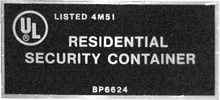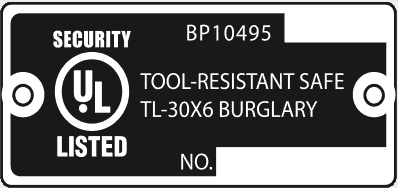According to the FBI, a home or office is broken into every 13 seconds With that in mind, it’s imperative that valuables such as jewelry, guns, cash, and even important business documents are properly stored in a high-security safe. High-security safes are those that have been awarded certificates and accreditations, from independent third-party laboratories, for their tool resistance, fire rating, and cash rating (insurance). These ratings ensure the safe’s ability to protect its contents from theft, tampering, fire, and other extreme conditions. If you’re in the market for a safe, but not sure where to start, the following article will detail what you need to look for and consider before purchasing a high-security safe.
1. Tool Resistance
Many high-security safes are labeled for the protection they provide against theft and fire. A UL-rated safe is one that has been tested by Underwriters Laboratories to see how long each safe can withstand common attacks from thieves. UL-rated safes are some most secure safes on the market. Here are the different TL ratings and what they mean when it comes to the security of the safe.
RSC (Residential Security Container) – The door of the safe successfully resisted entry for 5 minutes when attacked against rigorous prying, drilling, punching, chiseling, and tampering attacks by UL technicians.

TL-15 (Tool Resistant for 15 Minutes) – The door of the safe successfully resisted entry for 15 minutes when attacked with common hand tools, picking tools, electric tools, grinding points, carbide drills, or pressure-applying devices.

TL-30 (Tool Resistant for 30 minutes) – The door of the safe successfully resisted entry for 30 minutes when attacked with common hand tools, picking tools, electric tools, grinding points, carbide drills, pressure applying devices, abrasive cutting wheels, and power saws.

TL-30×6 (Tool Resistant for 30 minutes, all 6 sides) – All six sides of the safe successfully resisted entry for 30 minutes when attacked with common hand tools, picking tools, electric tools, grinding points, carbide drills, pressure applying devices, abrasive cutting wheels, and power saws.

2. Fire Rating
Another important feature of high-security safes is their fire rating. Many safes come standard with an ETL fire rating from 30 minutes up to 120 minutes. These ETL ratings state how long a safe can keep its internal temperature below 350 degrees while being exposed to fire. For example, if the safe’s fire rating was 90 minutes at 1,600 degrees, the interior of the safe will remain at or below 350 degrees for 90 minutes in a fire that is 1,600 degrees Fahrenheit. In 2016, over 352,000 house fires caused over 5.6 billion dollars worth of damage. Some of these losses could have been mitigated had the owner stored their valuables in an ETL-certified fire-rated safe.
3. Cash Rating (Insurance Coverage)
Many businesses keep their cash from day-to-day transactions stored in a high-security safe. Most high-security safes have a cash rating which states how much insurance will payout if the security of the safe has been compromised. These ratings generally go hand-in-hand with the UL ratings.
A “B” class UL-rated safe will have a lower cash rating than a TL30x6 safe and vice versa. It’s important that the owner properly installs the safe, preferably by a professional. A safe will be awarded a higher cash rating if the owner has extra security measures in place such as the use of a burglar alarm system. Here is a general idea of how much insurance you can expect based on the UL rating of your safe.
| Type of Safe (Burglary Rating) | Coverage Without Burglar Alarm | Coverage With Burglar Alarm |
| UL-RSC | Up to $15,000 | Up to $30,000 |
| UL TL-15 | Up to $100,000 | Up to $200,000 |
| UL TL-30 | Up to $195,000 | Up to $375,000 |
| UL TL-30×6 | Up to $275,000 | Up to $500,000 |
4. Mounting & Installation
If someone managed to break into your home, you would want to make sure that your safe is secure. For maximum protection, it’s advised that you mount your safe to the floor to prevent it from being stolen. Some safes can even be installed in the walls of your home or office, making them difficult to find. Although these installations can be done on your own, it’s recommended that you consult a licensed safe technician to install your safe in order to prevent any damage to your safe or your home. The cost of having your safe professionally installed can range anywhere from a few hundred dollars up to about a thousand dollars. The charge can vary depending on the safe side and access to the final mounting position. Be mindful of any small hallways or stairways that the safe has to travel through before reaching its final destination.
5. Choosing Trusted Providers
Many online safe dealers can ship a safe to your house, but that’s it. These dealers can’t provide the level of after-sales support that a brick-and-mortar location can. If the safe is too large to move by yourself, you will have to call a trusted safe moving service in order to get the safe to its final destination. A reputable safe dealer should be able to not only sell you the safe but install it and provide any future additional servicing your safe may need. Here at Houston Safe & Lock, we have the largest indoor showroom of safes in Houston. With over 400 safes to choose from, there’s something for everyone. Visit our local showroom or give us a call today to speak to one of our safe experts who will help you pick out a safe that’s right for you. We are Houston’s leader in security.